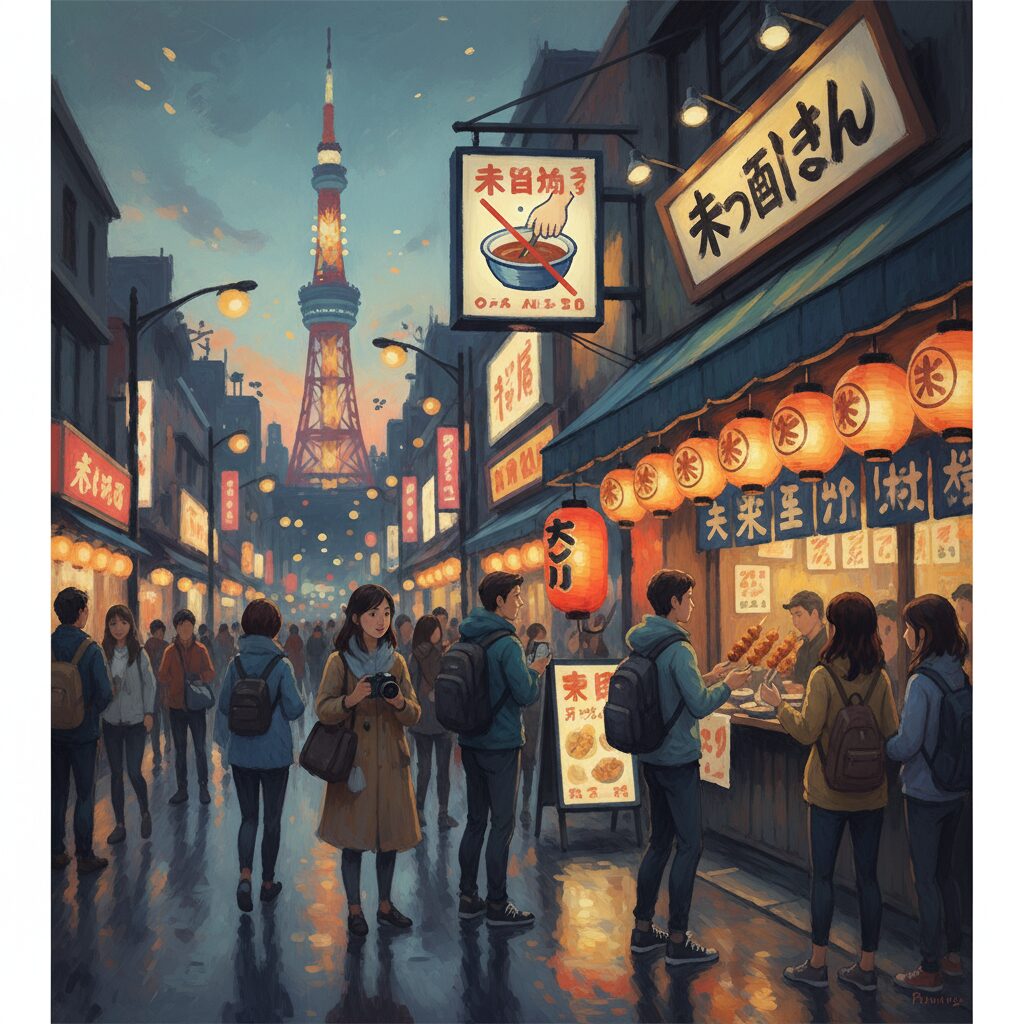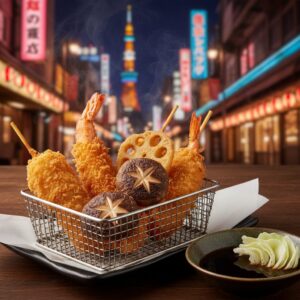Step off the train at Dobutsuen-mae Station, and the air changes. It’s a subtle shift at first, a current in the urban ocean of Osaka, but it quickly grows into a wave of pure, unadulterated nostalgia. You’ve arrived in Shinsekai, a neighborhood that wears its history not like a dusty museum piece, but like a favorite, well-worn jacket. This is Osaka’s “New World,” a district conceived over a century ago with grand dreams of Parisian avenues and New York’s Coney Island, and though time has weathered its ambitions, it has also infused it with a soul that is raw, vibrant, and utterly captivating. At the heart of this electric, retro-futuristic landscape stands the iconic Tsutenkaku Tower, a steel sentinel watching over a kingdom of sensory delights. But the true monarch here, the reason locals and travelers make their pilgrimage to these glowing streets, is a culinary tradition forged in the crucible of post-war resilience and working-class ingenuity: Kushikatsu. This is more than just deep-fried food on a stick; it’s a social ritual, a taste of history, and the delicious, crunchy heartbeat of Shinsekai itself. Prepare to dive into a world where the rules are simple, the flavors are bold, and every bite tells a story.
For a different take on Osaka’s rich street food culture, you can also explore the Halal soul food found in the neighboring Tengachaya area.
The Electric Heartbeat of Naniwa: What is Shinsekai?

To truly appreciate Kushikatsu, you must first grasp the essence of its home ground. Shinsekai isn’t a polished, manicured tourist spot. It’s gloriously and unapologetically authentic. Strolling down its main streets, you’re immersed in a vibrant tapestry of visual chaos. Massive, three-dimensional signs protrude from buildings: a giant fugu lantern glows with a cheerful menace, a stern-faced oversized chef stands guard at the entrance of a renowned Kushikatsu restaurant, and the mischievous smile of Billiken, the God of Things As They Ought to Be, promises good fortune to those who rub his feet. The atmosphere buzzes with the metallic clatter of pachinko parlors, the click of tiles from secretive mahjong games, and the sizzle of hot oil from countless kitchens. The area feels frozen in time, specifically the Showa Era (1926-1989), a period marked by rapid change and optimistic growth in Japan. “Shinsekai” means “New World,” a name given when it was established in 1912. The southern section was designed to resemble Paris, featuring a soaring steel tower, the original Tsutenkaku, inspired by the Eiffel Tower. The northern half was modeled after Coney Island, complete with an amusement park called Luna Park. It was envisioned as a bright, modern future. But history had other plans. The park closed, the original tower was dismantled for the war effort, and the neighborhood transformed into a hub for laborers, entertainers, and anyone seeking an affordable, lively time. This shift from a futuristic dream to a working-class refuge is exactly what gives Shinsekai its gritty, genuine charm and set the scene for its signature dish to thrive.
A Culinary Legend Born from Grit: The Story of Kushikatsu
Kushikatsu is the soul food of Shinsekai, with origins deeply intertwined with the neighborhood’s identity as a place for the everyday person. After World War II, laborers sought food that was quick, hearty, and affordable. Resourceful food stall owners began using inexpensive cuts of meat and seasonal vegetables, skewering them on bamboo sticks (kushi), dipping them in a flour-and-egg batter, coating them with fine panko breadcrumbs, and deep-frying them to a perfect golden brown (katsu means cutlet or fried). Served hot and fresh from the fryer alongside dipping sauce, it was the perfect meal—unpretentious, communal, and incredibly satisfying. Today, that humble spirit endures, even as Kushikatsu has become a celebrated culinary icon throughout Japan. The preparation exemplifies Japanese precision in the pursuit of simple perfection: the batter must be light enough to avoid greasiness, the panko fine enough to create a delicate, shatteringly crisp shell, and the oil temperature carefully managed to cook the inside without leaving the exterior oily. The result is a marvel of texture and flavor—a crispy crust giving way to a juicy, perfectly cooked interior. It’s a dish meant to be enjoyed with friends, gathered around a counter, a cold beer or highball in hand, sharing stories and laughter between crunchy, delicious bites. In every way, it captures the taste of Osaka: bold, straightforward, and deeply comforting.
The Golden Rule: Thou Shalt Not Double-Dip
Step into any Kushikatsu-ya (Kushikatsu restaurant), and two things become immediately apparent at the counter: a complimentary bowl of raw cabbage wedges and a communal stainless steel pot filled with a dark, glossy tonkatsu-style sauce. This shared sauce pot is the heart of the Kushikatsu experience, governed by one sacred, inviolable rule: no double-dipping. Once a skewer has touched your lips, it must never be dipped back into the communal sauce. This is not merely a suggestion but a fundamental aspect of Kushikatsu etiquette, rooted in respect for public health and consideration for fellow diners. Signs posted in Japanese—and sometimes in bluntly humorous English—make this abundantly clear. But what if you need more sauce halfway through a skewer? This is where the cabbage comes in. The crisp, raw leaves serve not only as a palate cleanser to cut through the richness of the fried food but also as a utensil. You can use a fresh cabbage wedge to scoop sauce and drizzle it over your skewer. This clever system lets you re-sauce your food without breaking the ultimate culinary rule. Embracing this tradition is your gateway into local culture—observing it shows respect and understanding and will earn you a quiet, appreciative nod from the chef behind the counter. This simple act transforms eating into a shared, respectful ritual.
A Symphony on a Stick: Exploring the Kushikatsu Menu
Part of Kushikatsu’s charm lies in its vast variety. A typical menu may seem overwhelming at first, listing ingredients that prove almost anything can be improved by a deep-frying journey. Yet exploring this range is a delightful adventure. Skewers are ordered individually or in sets, allowing you to tailor your meal precisely. Starting with the classics is a good idea. Gyu-katsu (beef), especially popular in Osaka, is tender and flavorful. Buta-katsu (pork) is a juicy staple, while tori (chicken) or uzura no tamago (quail eggs) offer lighter options, becoming delightful creamy spheres inside their crispy cases. Seafood enthusiasts will enjoy choices like ebi (shrimp), hotate (scallops), and ika (squid). The vegetable section is where true excitement begins—tamanegi (onion) turns sweet and soft, renkon (lotus root) provides a fantastic crunch, shiitake mushrooms absorb oil and sauce flavors beautifully, and nasu (eggplant) becomes velvety and rich. Then there are the wild cards that bring smiles: camembert cheese melts into a gooey delight, mochi (pounded rice cake) transforms into a chewy, crispy treat, and some establishments even serve dessert skewers like fried bananas or strawberries. Ordering happens in rounds: start with a few skewers, enjoy them piping hot, then order more. This unhurried rhythm allows you to savor each skewer and pace your appetite. Don’t hesitate to point at what looks good or ask the chef for their recommendation (osusume). Each skewer arriving fresh and glistening from the fryer is a small, perfect moment of culinary bliss.
Navigating the Labyrinth: Finding Your Perfect Kushikatsu Spot

Shinsekai is filled with Kushikatsu restaurants, making the choice of where to eat part of the adventure. These range from large, brightly lit venues known nationwide to small, hole-in-the-wall counters operated by the same family for generations. There isn’t a single “best” spot; the ideal choice depends on the experience you want. Well-known chains, like Kushikatsu Daruma with its iconic angry chef mascot, offer an excellent starting point. They cater to tourists, often provide English menus, and deliver consistently high-quality dishes. Starting here is a reliable way to learn the basics. For a more intimate and arguably more authentic experience, explore the narrower side streets or the famous Janjan Yokocho Alley. In these areas, you’ll find smaller establishments, often with just a dozen seats arranged around a single counter. The menu might be exclusively in Japanese, and the chef may not speak English, but the welcome is warm and the atmosphere steeped in local character. A good approach is to peek inside. Look for places bustling with locals, where cheerful conversation spills out onto the street. Check the chef’s station—is it clean and well-organized? Does the oil appear fresh? Most importantly, does the place feel right? The interior of a traditional Kushikatsu-ya highlights functional simplicity. A wooden counter, smoothed by decades of use, separates you from the chef. Behind them are raw, skewered ingredients neatly arranged in a refrigerated display, alongside the gleaming deep fryer where the magic happens. You sit on a simple stool, place your order, and watch the expert at work. It’s a front-row seat to a culinary performance and an experience that feels deeply and authentically Japanese.
Beyond the Fryer: Exploring the Soul of Shinsekai
While Kushikatsu remains the undeniable highlight, Shinsekai presents a full array of supporting attractions that make it an intriguing place to explore for an entire afternoon or evening. The neighborhood’s charm goes well beyond its eateries, offering a vibrant mix of sights, sounds, and experiences.
The Guardian of the South: Tsutenkaku Tower
Towering over the skyline is Tsutenkaku Tower, known as the “Tower Reaching Heaven.” The current structure, erected in 1956, is the second of its kind and stands as a cherished symbol of Osaka’s resilience and spirit. Riding the elevator to the main observation deck on the fifth floor reveals a breathtaking panoramic view of the city. You can admire the expansive Tennoji Park and Zoo below, the sparkling skyscrapers of Umeda off in the distance, and the intricate maze of city streets. The observatory also houses a prominent shrine dedicated to Billiken, the smiling, cherubic deity. Originally an American charm doll, Billiken was enshrined in the old Luna Park and has become a beloved symbol of Shinsekai. Rubbing the soles of his feet is believed to bring good luck, and both locals and tourists line up to partake. The tower itself is a retro gem, especially at night when it lights up with a dazzling array of seasonal LED displays.
A Journey Through Time: Janjan Yokocho Alley
Running along the east side of Shinsekai is Janjan Yokocho, a narrow, covered shopping arcade that feels like stepping into the past. The alley’s name comes from the “janjan” sound of shamisen that once played to lure customers. Today, the soundtrack is a lively blend of sizzling grills, animated conversation, and the clicking of shogi (Japanese chess) pieces. This is the vibrant core of old-school Osaka. The alley is filled with tiny standing bars (tachinomi), affordable and cheerful sushi spots, off-track betting parlors, and shogi clubs where elderly men engage in intense strategic battles for hours. It’s a place where time seems to slow down. Peering into these venues offers a snapshot of local daily life. Though less polished than Shinsekai’s main streets, it brims with an authenticity that is both captivating and warmly endearing.
Urban Retreats and World Baths: Spa World and Tennoji Park
If the sensory rush of Shinsekai becomes overwhelming, two excellent retreats lie just nearby. To the south is Tennoji Park, a vast green oasis that includes Tennoji Zoo and the Osaka City Museum of Fine Arts. It’s an ideal spot for a peaceful stroll to relax after a meal. Even more renowned is Spa World, a vast hot spring complex as extravagantly unique as Shinsekai itself. It features themed baths from around the world, divided into European and Asian zones (which rotate monthly between genders). Here, you can soak in a Roman-style bath, a Finnish sauna, or an open-air Japanese onsen, all under one roof. It’s the ultimate in relaxation and offers a surreal, delightful contrast to the vibrant streets just outside.
Practicalities for the Intrepid Traveler

Shinsekai, with all its old-world charm, is surprisingly easy to access and navigate. A bit of preparation will help ensure your visit is smooth, delicious, and unforgettable.
Getting There: Your Entrance to the New World
Shinsekai is situated in the southern part of central Osaka and is well-connected by public transportation. From the busy hubs of Umeda or Namba, the most direct way is the Osaka Metro Midosuji Line, heading southbound to Dobutsuen-mae Station. From there, it’s only a two-minute walk to the district’s center. Alternatively, you can take the Sakaisuji Line to either Dobutsuen-mae or Ebisucho Station, both located at the foot of Tsutenkaku Tower. For travelers with a Japan Rail Pass, the JR Osaka Loop Line is another great choice—disembark at Shin-Imamiya Station, which connects to Dobutsuen-mae and is just a short walk away. These multiple access points make Shinsekai an easy and convenient spot to add to any Osaka itinerary.
When to Go: Day and Night in Shinsekai
Shinsekai shows two distinct personalities depending on the time of day, both worth experiencing. During the daytime, the mood is more relaxed, with locals going about their daily routines. It’s a perfect time to visit Tsutenkaku Tower or explore Janjan Yokocho when the shogi clubs are active. Restaurants are open, but the atmosphere is quieter. As evening falls, however, Shinsekai transforms into a magical scene. Neon signs and paper lanterns brighten up, casting the streets in a warm, electric glow. The area fills with people seeking dinner and entertainment. Energy heightens, sounds grow louder, and the neighborhood takes on the feel of a lively, ongoing festival. For the true Shinsekai experience, it’s best to arrive in the late afternoon and stay through the evening to witness this striking change.
Tips for a Perfect First Visit
To fully enjoy your Kushikatsu experience, keep a few tips in mind. First, while more places are starting to accept credit cards, many smaller, family-run shops in Shinsekai remain cash-only, so it’s wise to carry enough yen. Second, don’t let language barriers discourage you. A smile and pointing to your desired item go a long way. Learning a few key phrases like “Kore o kudasai” (This one, please) and “Oishii!” (Delicious!) will be warmly welcomed. Third, remember that Kushikatsu tastes best when hot—order in small batches rather than all at once to ensure every skewer is fresh from the fryer. Finally, and very importantly, observe the golden rule: no double-dipping. Your fellow diners will appreciate it.
The Enduring Spirit of Osaka
A visit to Shinsekai is more than simply a meal; it’s an immersion into a part of Japan that resists being smoothed over or sanitized. It celebrates the past, honors the city’s working-class roots, and defiantly stands against the relentless advance of modernity. In the satisfying crunch of a perfectly fried skewer, in the shared pot of sauce that unites strangers, and in the neon-lit streets beneath the watchful gaze of Tsutenkaku Tower, you discover the true spirit of Osaka—a spirit that is warm, unpretentious, a bit loud, and brilliantly alive. It’s a flavor and feeling that lingers long after you’ve boarded the train and returned to the polished, predictable world outside. Shinsekai doesn’t just satisfy your hunger; it nourishes your soul.






